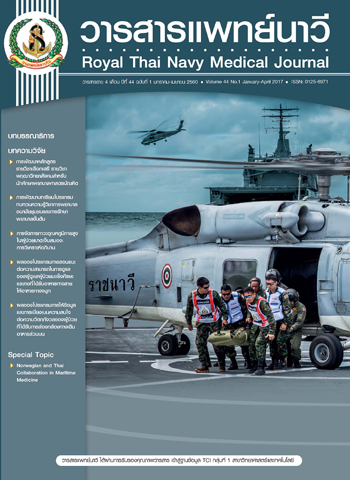การจัดการภาวะอุณหภูมิกายสูงในผู้ป่วยบาดเจ็บสมอง : การวิเคราะห์อภิมาน
Main Article Content
Abstract
The purposes of this meta-analysis were to 1) collect and analyze evidence related
to research on hyperthermia management in traumatic brain injury patients, 2) describe
characteristics of research on hyperthermia management in traumatic brain injury patients,
3) analyze the effect sizes of hyperthermia management in traumatic brain injury patients,
and 4) synthesize knowledge gained from the study to develop further research. In this
study, 6 studies conducted in Thailand between 1989 and 2013 were included from a thesis
and research reports. The instruments used to collect the information were a summary of
the research report and an assessment of research quality form. The effect sizes were
calculated for each study using the method of Glass, McGaw, and Smith.14 This
meta-analysis yielded 11 effect sizes. The results of this meta-analysis were as follows:
1. All of these studies were in Master degree of nursing science (100%). Half of the
studies (50%) were published between 2009 and 2013. The research studies had a high
level of reliability and were quasi-experimental research (66.67%). The total of sample were
traumatic brain injury patients (100%). The method for hyperthermia management can be
identified into two types: hyperthermia management by using antipyretic medications
combined with other methods (50%) and hyperthermia management without using
antipyretic medications (50%). The result of the studies was body temperature (100%).
2. Mean of the effect sizes on hyperthermia management (d = -0.52) with negative
value between -0.41 and -0.66. The largest effect size of hyperthermia management was
the local head and neck cooling without using antipyretic medications (d = -0.66). While the
tepid sponge with cold water combined with a fan without using antipyretic medications
had a smallest effect size (d = -0.41).
Article Details

This work is licensed under a Creative Commons Attribution-NonCommercial-NoDerivatives 4.0 International License.
References
2. Samii A. The neurobiological basis of fever. Surgical Neurology 1996;45(4):392-93.
3. Thompson HJ, Tkacs NC, Saatman KE, Raghupath R, McIntosh TK. Hyperthermia following traumatic brain injury: a critical evaluation. Neurobio Dis 2003;12(3):163-73.
4. Mcilvoy L. Fever Management in Patients with Brain Injury. AACN Adv Crit Care 2012;23(2):204-11.
5. Thompson HJ, Kirkness CJ, Mitchell PH. Intensive care unit management of fever following traumatic brain injury. Intensive Crit Care Nurs 2007;23(2):91-6.
6. Stocchetti N, Rossi S, Zanier ER, Colombo A, Beretta L, Citerio G. Pyrexia in head-injured patients admitted to intensive care. Intensive Care Med 2002;28(11):1555-62.
7. Bao L, Chen D, Ding L, Ling W, Xu F. Fever Burden Is an Independent Predictor for Prognosis of Traumatic Brain Injury. PLoS ONE 2014;9(3):e90956.
8. Dietrich WD, Bramlett HM. Hyperthermia and central nervous system injury. Prog Brain Res 2007;162:201-17.
9. Bota PD, Ferreira LF, Melot C, Vincent LJ. Body temperature alterations in the critically ill. Intensive Care Med 2004;30(5):811-6.
10. Beard RM, Day MW. Fever and hyperthermia: learn to beat the heat. Nursing 2008;38(6):28-31.
11. Kiekkas P, Aretha D, Bakalis N, Karpouhtsi I, Marneras C, Baltopoulos GI. Fever effects and treatment in critical care: Literature review. Aust Crit Care 2013;26(3):130-5.
12. Kiekkas P, Brokalaki H, Manolis E, Askotiri P, Karga M. Baltopoulos GI. Fever and standard monitoring parameters of ICU patients: A descriptive study. Intensive Crit Care Nurs 2007;23(5):281-8.
13. Thompson HJ, Pinto-Martin J, Bullock MR. Neurogenic fever after traumatic brain injury: an epidemiological study. J Neurol Neurosurg Psychiatry 2003;74(5):614-9.
14. Glass GV, McGaw B, Smith ML. Meta-analysis in social research. London: Sage Publications; 1981.
15. The Joanna Briggs Institute. Joanna Briggs Institute Reviewer's Manual 2014 edition. [Internet]. [cited 2015 December 4]. Available from: https://joannabriggs.org/assets/docs/sumari/reviewersmanual-2014.pdf.
16. จริยา วงศ์นาม. ผลของการเช็ดตัวการอาบน้ำการประคบด้วยผ้าเปียกและการรับประทานยาลดไข้ที่มีต่อการเปลี่ยนแปลงอุณหภูมิร่างกายในเด็กที่มีไข้. [วิทยานิพนธ์พยาบาลศาสตรมหาบัณฑิต สาขาวิชาการพยาบาลเด็ก]. มหาวิทยาลัยมหิดล; 2524.
17. ธัญญา กาญจนรชตะ. เปรียบเทียบผลการเรียนรู้เรื่องการเช็ดตัวลดไข้ของผู้ดูแลผู้ป่วยที่ได้รับการสอนโดยการบรรยายและสาธิตกับการสอนโดยใช้สื่อวีดิทัศน์. [วิทยานิพนธ์พยาบาลศาสตรมหาบัณฑิต สาขาวิชาการพยาบาลเด็ก]. มหาวิทยาลัยบูรพา; 2550.
18. เพชราภรณ์ ศิริทรัพย์. การพัฒนาและการใช้แนวปฏิบัติทางคลินิกสำหรับการจัดการไข้ในผู้ป่วยเด็ก. [วิทยานิพนธ์พยาบาลศาสตรมหาบัณฑิต สาขาวิชาการพยาบาลเด็ก]. มหาวิทยาลัยเชียงใหม่; 2552.
19. ยุพิน ดีสมศักดิ์. ผลของการเช็ดตัวร่วมกับประคบด้วยผ้าเปียก การประคบด้วยผ้าเปียกและการอาบน้ำที่มีผลต่อการเปลี่ยนแปลงอุณหภูมิในร่างกายเด็กที่มีไข้. [วิทยานิพนธ์พยาบาลศาสตรมหาบัณฑิต สาขาวิชาการพยาบาลเด็ก]. มหาวิทยาลัยมหิดล; 2525.
20. ศรีพรรณ กันธวัง. การจัดการอาการไข้ในเด็ก. Best practice: Evidence Based Practice Information Sheets for Health Professionals 2011;5(5):1-10.
21. ศิริพร อิทรคำแหง. ผลของการอาบน้ำและเช็ดตัวที่มีต่ออุณหภูมิร่างกายของทารกแรกเกิด. [วิทยานิพนธ์พยาบาลศาสตรมหาบัณฑิต สาขาวิชาการพยาบาลเด็ก]. มหาวิทยาลัยมหิดล; 2526.
22. สมฤดี เลิศงามมงคล. การเปรียบเทียบประสิทธิผลของการเช็ดตัวลดไข้และการติดแผ่นไฮโดรเจลต่อระดับอุณหภูมิของผู้ป่วยเด็กที่มีไข้. งานมหกรรมคุณภาพฟื้นฟูวิชาการโรงพยาบาลชลบุรี; 2556. หน้า 1-2.
23. ชุติมา อรุโณทยานันทร์. การลดไข้ในผู้ป่วยที่บาดเจ็บที่ศีรษะที่มีไข้เนื่องจากพยาธิสภาพ. [วิทยานิพนธ์พยาบาลศาสตรมหาบัณฑิต สาขาวิชาการพยาบาลผู้ใหญ่]. มหาวิทยาลัยมหิดล; 2544.
24. ดวงเพ็ญ แวววันจิตร. การพัฒนาและการประเมินผลการใช้แนวปฏิบัติทางการพยาบาลในการจัดการกับภาวะไข้ในผู้ป่วยบาดเจ็บที่สมอง โรงพยาบาลสงขลานครินทร์. [วิทยานิพนธ์พยาบาลศาสตรมหาบัณฑิตสาขาวิชาการพยาบาลผู้ใหญ่]. มหาวิทยาลัยสงขลานครินทร์; 2554.
25. นิรันดร์ นายกชน. ประสิทธิภาพของเครื่องมือให้ความเย็นเฉพาะที่บริเวณศีรษะและคอต่อการลดอุณหภูมิเทียบเคียงสมองในผู้ป่วยบาดเจ็บที่สมองรุนแรง. [วิทยานิพนธ์พยาบาลศาสตรมหาบัณฑิต สาขาวิชาการพยาบาลผู้ใหญ่]. มหาวิทยาลัยขอนแก่น; 2554.
26. นิภาวรรณ สามารถกิจ. การเปรียบเทียบผลของการเช็ดตัวร่วมกับการประคบด้วยผ้าเปียกกับการเช็ดตัวร่วมกับการใช้พัดลมเป่าต่อการเปลี่ยนแปลงอุณหภูมิร่างกายในผู้ป่วยบาดเจ็บทางสมองที่มีไข้. [วิทยานิพนธ์พยาบาลศาสตรมหาบัณฑิต สาขาวิชาการพยาบาลผู้ใหญ่]. มหาวิทยาลัยมหิดล; 2532.
27. พิรานันท์ เงินแก้ว. การพัฒนาแนวปฏิบัติทางคลินิกสำหรับการจัดการภาวะอุณหภูมิกายสูงในผู้ป่วยบาดเจ็บสมองโรงพยาบาลเชียงรายประชานุเคราะห์. [วิทยานิพนธ์พยาบาลศาสตรมหาบัณฑิตสาขาวิชาการพยาบาลผู้ใหญ่]. มหาวิทยาลัยเชียงใหม่; 2556.
28. สุวรรณี ทาอ่อน. ผลของการเช็ดตัวลดไข้ด้วยน้ำเย็นและน้ำธรรมดาร่วมกับการใช้พัดลมในผู้ป่วยบาดเจ็บที่ศีรษะที่มีไข้. [วิทยานิพนธ์พยาบาลศาสตรมหาบัณฑิต สาขาวิชาการพยาบาลผู้ใหญ่]. มหาวิทยาลัยเชียงใหม่; 2539.
29. Cohen J. Statistical power analysis for the behavioral science. 2nd ed. Hillsdale, NJ: Lawrence Erlbaum Associates; 1988.
30. Guyton AC. Textbook of medical physiology. Philadelphia: W.B.Saunder Company; 1991.
31. Caruso CC, Hadley BJ, Shukla R, Frame P, Khoury J. Cooling effects and comfort of four cooling blanket temperatures in humans with fever. Nurs Res 1992;41(2):68-72.
32. Bartlett EM. Temperature measurement: why and how in intensive care. Intensive CritCare Nurs 1996;12(1):50-4.
33. Fulbrook P. Core temperature measurement: a comparison of rectal, axillary and pulmonary artery blood temperature. Intensive Crit Care Nurs 1993;9(4):217-25.

